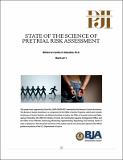| dc.contributor.author |
Cynthia A. Mamalian, Ph.D. |
| dc.coverage.spatial |
United States |
| dc.date.accessioned |
2016-01-07T15:29:08Z |
| dc.date.available |
2016-01-07T15:29:08Z |
| dc.identifier.uri |
http://desa1.cejamericas.org:8080/handle/2015/3454 |
| dc.description.abstract |
The most important decision that is made with respect to a newly arrested defendant is whether to release that defendant into the community while awaiting trial; getting that decision right is critically important for both the defendant and the community at-large. In June 2010, the Pretrial Justice Institute (PJI) and the Office of Justice Programs’ Bureau of Justice Assistance (BJA) convened a meeting of researchers and practitioners to discuss the current state of the science and practice of pretrial justice. This document summarizes the key points that came out of that discussion and what leaders in the field identified as significant next steps in advancing the administration of pretrial justice, ensuring efficient and effective release and detention decisions for pretrial defendants, managing defendant risk through appropriate and specific conditions of release, and balancing the rights of defendants with community safety.This publication is designed for a wide-ranging audience of criminal justice stakeholders who have questions about pretrial risk assessment and its value to the pretrial justice process. The first section of this publication provides a brief review of the history and current state of pretrial justice. The second section looks at critical issues related to pretrial release, detention, and risk assessment. The third section discusses challenges to implementing evidence-based1 risk assessment and threats to reliable administration, including time constraints and practicality of the risk assessment instrument, money bail schedules, local capacity, subjective risk assessment, and court culture and judicial behavior. The fourth section of the document outlines methodological challenges associated with the prediction of risk. The final section provides recommendations for research and practice. We discuss high priority research activities, the potential for a universal risk assessment instrument, and the need for training and technical assistance. |
| dc.description.abstract |
Reseña: The most important decision that is made with respect to a newly arrested defendant is whether to release that defendant into the community while awaiting trial; getting that decision right is critically important for both the defendant and the community at-large. In June 2010, the Pretrial Justice Institute (PJI) and the Office of Justice Programs’ Bureau of Justice Assistance (BJA) convened a meeting of researchers and practitioners to discuss the current state of the science and practice of pretrial justice. This document summarizes the key points that came out of that discussion and what leaders in the field identified as significant next steps in advancing the administration of pretrial justice, ensuring efficient and effective release and detention decisions for pretrial defendants, managing defendant risk through appropriate and specific conditions of release, and balancing the rights of defendants with community safety.This publication is designed for a wide-ranging audience of criminal justice stakeholders who have questions about pretrial risk assessment and its value to the pretrial justice process. The first section of this publication provides a brief review of the history and current state of pretrial justice. The second section looks at critical issues related to pretrial release, detention, and risk assessment. The third section discusses challenges to implementing evidence-based1 risk assessment and threats to reliable administration, including time constraints and practicality of the risk assessment instrument, money bail schedules, local capacity, subjective risk assessment, and court culture and judicial behavior. The fourth section of the document outlines methodological challenges associated with the prediction of risk. The final section provides recommendations for research and practice. We discuss high priority research activities, the potential for a universal risk assessment instrument, and the need for training and technical assistance. |
| dc.language.iso |
English |
| dc.title |
State of the Science of Pretrial Risk Assessment (2011) |
| dc.ceja.source |
Fuente: Pretrial Justice Institute, www.pretrial.org, Bureau of Justice Assistance |

